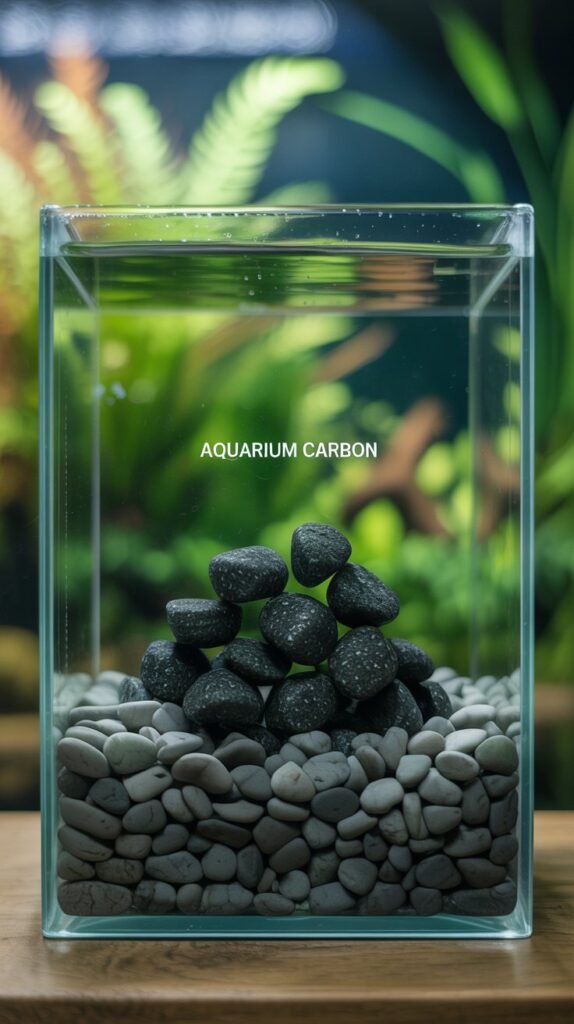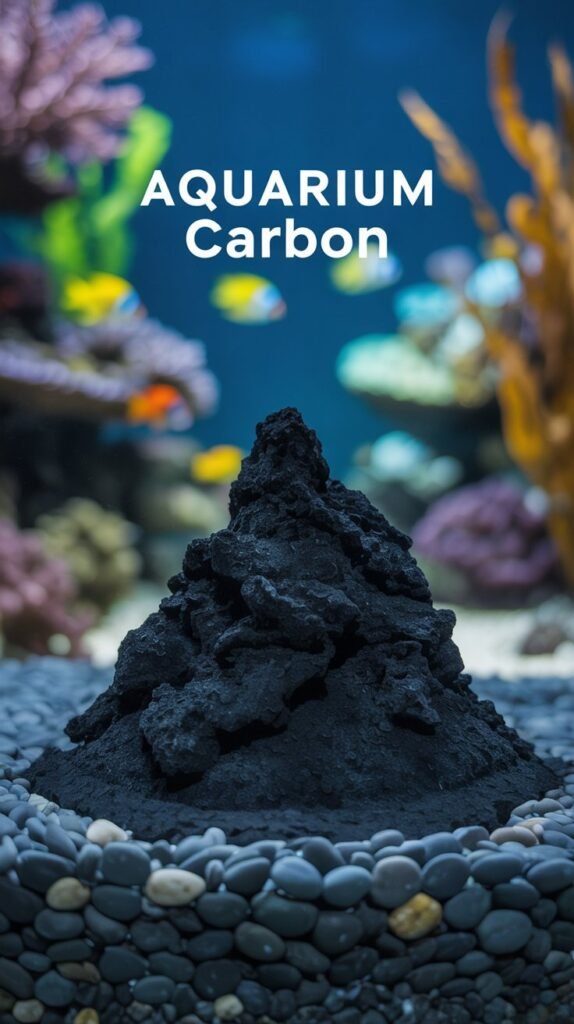Aquarium keeping is an exciting hobby, but maintaining crystal-clear water and a healthy aquatic environment requires more than just a filter and regular water changes. One of the most widely discussed topics among aquarists is the use of aquarium carbon, particularly activated carbon, in filtration systems.
Aquarium carbon has been around for decades and is commonly used in freshwater and saltwater tanks. However, many beginners and even experienced hobbyists often ask: Is aquarium carbon really necessary? What does it do? How often should it be replaced?
In this comprehensive guide, we’ll explore everything you need to know about aquarium carbon—its types, benefits, drawbacks, how it works, when to use it, and whether it is right for your aquarium setup.
What is Aquarium Carbon?
Aquarium carbon generally refers to activated carbon, a highly porous form of carbon processed to have an enormous surface area. This surface area allows it to adsorb (not absorb) impurities, toxins, and dissolved organic compounds from aquarium water.

Key Features of Aquarium Carbon:
- Made from materials like coal, coconut shells, or wood.
- Heated at high temperatures to increase porosity.
- Works through adsorption, where molecules cling to its surface.
- Used inside filter media bags, cartridges, or canisters.
Unlike biological or mechanical filtration, activated carbon specifically targets chemical impurities.
How Does Aquarium Carbon Work?
Activated carbon removes substances through adsorption. This means impurities stick to the surface of the carbon rather than being absorbed into it.
Substances Removed by Aquarium Carbon:
- Organic pollutants – leftover food, fish waste, and decaying matter.
- Tannins – from driftwood that make water appear tea-colored.
- Odors – keeps water fresh-smelling.
- Medications – carbon clears leftover medicines after fish treatments.
- Chlorine and chloramine – in some cases, carbon helps neutralize these (though water conditioners are better for this purpose).
Substances NOT Removed by Carbon:
- Ammonia
- Nitrite
- Nitrate
- Heavy metals (most types cannot remove them effectively)
- Phosphate (unless specifically designed)
This is why carbon does not replace biological or mechanical filtration but complements them.
Types of Aquarium Carbon

There are different types of activated carbon available for aquariums:
- Granular Activated Carbon (GAC)
- Most common form.
- Comes as small granules.
- High surface area and easy water flow.
- Pelletized Carbon
- Compressed into uniform pellets.
- Denser than granular carbon.
- Good for large canister filters.
- Powdered Carbon
- Very fine particles.
- Works quickly but not commonly used in aquariums.
- Coconut Shell Carbon
- Eco-friendly and renewable source.
- Very high adsorption capacity.
- Popular among aquarists.
Each type has its advantages, but granular activated carbon is most commonly used in hobby aquariums.
Benefits of Using Aquarium Carbon
Aquarium carbon can significantly improve water quality when used correctly. Here are its main benefits:
1. Crystal-Clear Water
Carbon removes tannins and dissolved organics that cause water discoloration, leaving your tank sparkling clear.
2. Odor Control
Keeps the aquarium smelling fresh, especially in heavily stocked tanks.
3. Removes Toxins
Helps reduce harmful organic waste buildup.
4. Removes Medication After Treatment
After treating fish with antibiotics or anti-parasitic medications, carbon clears leftover chemicals to prevent long-term harm.
5. Enhances Light Penetration
Clearer water allows better light penetration, which benefits live plants and corals.
Drawbacks of Aquarium Carbon

While carbon has many benefits, it also comes with some drawbacks.
- Not Permanent
- Carbon becomes “full” over time and stops adsorbing impurities.
- Needs replacement every 2–4 weeks.
- Removes Beneficial Substances
- Can remove certain fish medications while in use.
- May strip some essential trace elements (though in minor amounts).
- Maintenance Required
- Needs regular replacement, adding cost to aquarium upkeep.
- Not a Substitute for Biological Filtration
- Does not remove ammonia, nitrites, or nitrates.
- Cannot replace the nitrogen cycle.
How to Use Aquarium Carbon
Using aquarium carbon is simple, but following best practices ensures maximum efficiency.
Placement in Filter:
- Place carbon in a filter media bag or cartridge.
- Position it after mechanical filtration (sponges/floss) but before biological filtration (ceramic rings, bio balls).
- This ensures water is free of debris before passing through carbon.
Amount to Use:
- General guideline: 1/2 cup per 50 gallons of water.
- Adjust depending on water quality, bioload, and filter size.
Replacement Frequency:
- Replace carbon every 2–4 weeks.
- Spent carbon can begin leaching impurities back into the tank.
Rinsing Carbon:
- Always rinse carbon thoroughly before use to remove dust.
Do You Really Need Aquarium Carbon?
This is one of the most debated questions in fishkeeping. Some aquarists swear by it, while others never use it.
When You SHOULD Use Aquarium Carbon:
- After fish medication treatments.
- When driftwood tannins discolor water.
- In tanks with odor issues.
- In community aquariums with sensitive species.
When You DON’T Need Aquarium Carbon:
- In heavily planted aquariums (plants naturally absorb organics).
- If water is already clear and odor-free.
- In tanks where dosing fertilizers or trace elements (carbon may remove them).
Alternatives to Aquarium Carbon
If you prefer not to use carbon, other chemical filtration options exist:
- Zeolite – Removes ammonia in freshwater tanks.
- Purigen – Synthetic resin that removes organics and polishes water.
- Chemi-Pure – A mix of carbon and ion-exchange resins.
- Poly-Filter Pads – Remove impurities and change color to indicate saturation.
These alternatives can sometimes be more cost-effective and longer-lasting than carbon.
Aquarium Carbon in Freshwater vs. Saltwater Tanks
- Freshwater Tanks: Most beneficial for removing tannins, odors, and keeping water clear.
- Saltwater Tanks: Useful in removing dissolved organics and yellowing compounds that block light for corals. However, reef keepers often prefer specialized resins instead of carbon.
Common Mistakes with Aquarium Carbon
- Leaving it too long – Spent carbon can leach back toxins.
- Using too much – Excessive carbon can remove beneficial compounds.
- Not rinsing – Dust can cloud water temporarily.
- Using during medication – Carbon removes medicine before it works.
Conclusion
Aquarium carbon remains one of the most useful tools for maintaining water clarity, removing odors, and eliminating dissolved organics. While not essential for every aquarium setup, it plays an important role in specific cases—especially after treatments or when dealing with tannins and odors.
Whether you choose to use aquarium carbon or alternatives, the key is understanding your tank’s needs. By using it correctly, you can ensure your fish, plants, and corals thrive in a healthy and beautiful aquatic environment.
FAQs About Aquarium Carbon
Q1: How often should I replace aquarium carbon?
A: Typically every 2–4 weeks, depending on water conditions and tank size.
Q2: Can I use aquarium carbon all the time?
A: Yes, but it’s not always necessary. Many aquarists only use it after medications or when water clarity declines.
Q3: Does aquarium carbon remove ammonia and nitrates?
A: No, carbon does not remove ammonia, nitrites, or nitrates. Biological filtration handles those.
Q4: Can I recharge aquarium carbon?
A: No, once carbon is saturated, it cannot be effectively regenerated at home. Replacement is necessary.
Q5: Is aquarium carbon safe for shrimp and snails?
A: Yes, it’s safe for invertebrates and will not harm shrimp, snails, or other sensitive species.
Q6: Should I remove carbon during fish medication?
A: Yes, always remove carbon before dosing medication, as it will adsorb the treatment and make it ineffective.
Q7: Is aquarium carbon necessary in a planted tank?
A: Not always. Planted tanks may not need carbon, as plants naturally absorb organics, and carbon can sometimes strip fertilizers.

